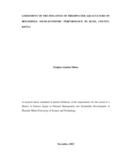| dc.description.abstract | Aquaculture has enhanced food security for over 2.5 billion people generated sources of livelihood for approximately 530 million people and contributed to approximately 40 per cent of the world’s fish production. There is a high demand for fish, however, fish cannot meet the demand from the capture fisheries. Busia County has been a beneficiary of the donor-funded project that funded aquaculture. From the foregoing, this study sought to assess the influence of freshwater aquaculture on household socioeconomic performance in Busia County, Kenya. specific objectives were to: determine freshwater aquaculture performance in Busia County; establish the effect of freshwater aquaculture on household socio-economic performance in Busia County; and determine aquaculture technology strategy on the freshwater aquaculture performance in Busia County. The study adopted a descriptive survey research design with both quantitative and qualitative methods. The target population was 55,608 households in Bunyala and Teso South sub-counties and a sample size of 384 households. A simple random sampling strategy was used to select the household heads and a purposive sampling strategy was used to select key informants. Questionnaires, interview schedules, focus group discussion guides and photography were used to collect data. Quantitative data were analysed using (SPSS) version 25.0 while qualitative data was analysed through verbatim reporting. Results revealed that private hatcheries dominated fingerling production hence the high cost of fingerlings. Fish feed was being sold at the local agrovets and was not quite affordable to farmers. Extension services were mainly pond management (96.1%; OR = 2.67), record keeping (92.7%) and fish marketing (77.7%). House hold size had a partial determination of the household socioeconomic performance. The cost of input was main a concern to 45% of the households as well as the market prices of the fish. Access to finance was not limited to 65% of the households. Earthen pond technology comprised 96% of the households. Aquaculture had a positive impact on the production of fish (73.8%). Conclusion: Private sector hatcheries were the main distributors of fingerlings to farmers. Pond management, recording keeping, and marketing were the main extension services accorded to households. The cost of inputs and market prices of fish and fish product was the average determinant of household socioeconomic performance. Households had access to financial support such as loans designed for aquaculture ventures. Earthen pond technology was the main technology strategy practised by the households in Busia County. Recommendations: Owing to the low investment in hatcheries by the national and county governments of Busia, there is a need to rethink the installation of government hatcheries in all sub-counties for ease of accessibility and affordability in order to promote the sustainability of aquaculture. The cost of inputs is quite high for local household farmers; thus, it is an area that the County Government of Busia to look to and help reduce the cost. Earthen pond technology is dominant, however, there is a need for subsidised lined pond systems to have as many farmers moving to lined ponds that are secure and safe for the fish and farmer. | en_US |

